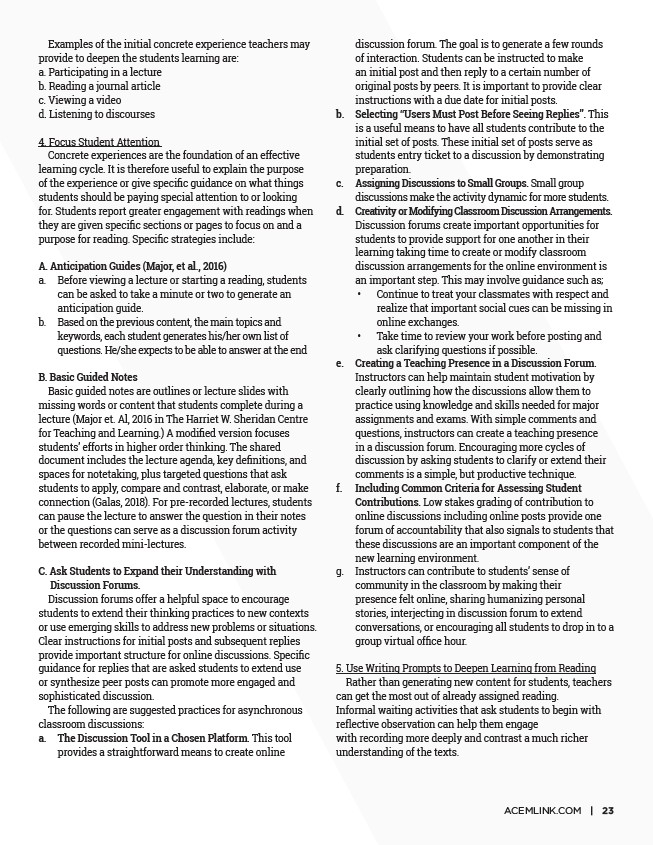
Examples of the initial concrete experience teachers may
provide to deepen the students learning are:
a. Participating in a lecture
b. Reading a journal article
c. Viewing a video
d. Listening to discourses
4. Focus Student Attention
Concrete experiences are the foundation of an effective
learning cycle. It is therefore useful to explain the purpose
of the experience or give specific guidance on what things
students should be paying special attention to or looking
for. Students report greater engagement with readings when
they are given specific sections or pages to focus on and a
purpose for reading. Specific strategies include:
A. Anticipation Guides (Major, et al., 2016)
a. Before viewing a lecture or starting a reading, students
can be asked to take a minute or two to generate an
anticipation guide.
b. Based on the previous content, the main topics and
keywords, each student generates his/her own list of
questions. He/she expects to be able to answer at the end
B. Basic Guided Notes
Basic guided notes are outlines or lecture slides with
missing words or content that students complete during a
lecture (Major et. Al, 2016 in The Harriet W. Sheridan Centre
for Teaching and Learning.) A modified version focuses
students’ efforts in higher order thinking. The shared
document includes the lecture agenda, key definitions, and
spaces for notetaking, plus targeted questions that ask
students to apply, compare and contrast, elaborate, or make
connection (Galas, 2018). For pre-recorded lectures, students
can pause the lecture to answer the question in their notes
or the questions can serve as a discussion forum activity
between recorded mini-lectures.
C. Ask Students to Expand their Understanding with
Discussion Forums.
Discussion forums offer a helpful space to encourage
students to extend their thinking practices to new contexts
or use emerging skills to address new problems or situations.
Clear instructions for initial posts and subsequent replies
provide important structure for online discussions. Specific
guidance for replies that are asked students to extend use
or synthesize peer posts can promote more engaged and
sophisticated discussion.
The following are suggested practices for asynchronous
classroom discussions:
a. The Discussion Tool in a Chosen Platform. This tool
provides a straightforward means to create online
discussion forum. The goal is to generate a few rounds
of interaction. Students can be instructed to make
an initial post and then reply to a certain number of
original posts by peers. It is important to provide clear
instructions with a due date for initial posts.
b. Selecting “Users Must Post Before Seeing Replies”. This
is a useful means to have all students contribute to the
initial set of posts. These initial set of posts serve as
students entry ticket to a discussion by demonstrating
preparation.
c. Assigning Discussions to Small Groups. Small group
discussions make the activity dynamic for more students.
d. Creativity or Modifying Classroom Discussion Arrangements.
Discussion forums create important opportunities for
students to provide support for one another in their
learning taking time to create or modify classroom
discussion arrangements for the online environment is
an important step. This may involve guidance such as;
• Continue to treat your classmates with respect and
realize that important social cues can be missing in
online exchanges.
• Take time to review your work before posting and
ask clarifying questions if possible.
e. Creating a Teaching Presence in a Discussion Forum.
Instructors can help maintain student motivation by
clearly outlining how the discussions allow them to
practice using knowledge and skills needed for major
assignments and exams. With simple comments and
questions, instructors can create a teaching presence
in a discussion forum. Encouraging more cycles of
discussion by asking students to clarify or extend their
comments is a simple, but productive technique.
f. Including Common Criteria for Assessing Student
Contributions. Low stakes grading of contribution to
online discussions including online posts provide one
forum of accountability that also signals to students that
these discussions are an important component of the
new learning environment.
g. Instructors can contribute to students’ sense of
community in the classroom by making their
presence felt online, sharing humanizing personal
stories, interjecting in discussion forum to extend
conversations, or encouraging all students to drop in to a
group virtual office hour.
5. Use Writing Prompts to Deepen Learning from Reading
Rather than generating new content for students, teachers
can get the most out of already assigned reading.
Informal waiting activities that ask students to begin with
reflective observation can help them engage
with recording more deeply and contrast a much richer
understanding of the texts.
ACEMLINK.COM | 23